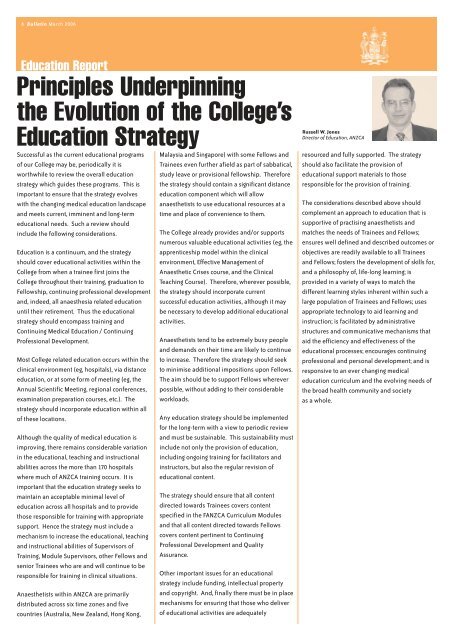ANZCA Bulletin - March 2006 - Australian and New Zealand College ...
ANZCA Bulletin - March 2006 - Australian and New Zealand College ...
ANZCA Bulletin - March 2006 - Australian and New Zealand College ...
You also want an ePaper? Increase the reach of your titles
YUMPU automatically turns print PDFs into web optimized ePapers that Google loves.
6 <strong>Bulletin</strong> <strong>March</strong> <strong>2006</strong><br />
Education Report<br />
Principles Underpinning<br />
the Evolution of the <strong>College</strong>’s<br />
Education Strategy<br />
Successful as the current educational programs<br />
of our <strong>College</strong> may be, periodically it is<br />
worthwhile to review the overall education<br />
strategy which guides these programs. This is<br />
important to ensure that the strategy evolves<br />
with the changing medical education l<strong>and</strong>scape<br />
<strong>and</strong> meets current, imminent <strong>and</strong> long-term<br />
educational needs. Such a review should<br />
include the following considerations.<br />
Education is a continuum, <strong>and</strong> the strategy<br />
should cover educational activities within the<br />
<strong>College</strong> from when a trainee first joins the<br />
<strong>College</strong> throughout their training, graduation to<br />
Fellowship, continuing professional development<br />
<strong>and</strong>, indeed, all anaesthesia related education<br />
until their retirement. Thus the educational<br />
strategy should encompass training <strong>and</strong><br />
Continuing Medical Education / Continuing<br />
Professional Development.<br />
Most <strong>College</strong> related education occurs within the<br />
clinical environment (eg, hospitals), via distance<br />
education, or at some form of meeting (eg, the<br />
Annual Scientific Meeting, regional conferences,<br />
examination preparation courses, etc.). The<br />
strategy should incorporate education within all<br />
of these locations.<br />
Although the quality of medical education is<br />
improving, there remains considerable variation<br />
in the educational, teaching <strong>and</strong> instructional<br />
abilities across the more than 170 hospitals<br />
where much of <strong>ANZCA</strong> training occurs. It is<br />
important that the education strategy seeks to<br />
maintain an acceptable minimal level of<br />
education across all hospitals <strong>and</strong> to provide<br />
those responsible for training with appropriate<br />
support. Hence the strategy must include a<br />
mechanism to increase the educational, teaching<br />
<strong>and</strong> instructional abilities of Supervisors of<br />
Training, Module Supervisors, other Fellows <strong>and</strong><br />
senior Trainees who are <strong>and</strong> will continue to be<br />
responsible for training in clinical situations.<br />
Anaesthetists within <strong>ANZCA</strong> are primarily<br />
distributed across six time zones <strong>and</strong> five<br />
countries (Australia, <strong>New</strong> Zeal<strong>and</strong>, Hong Kong,<br />
Malaysia <strong>and</strong> Singapore) with some Fellows <strong>and</strong><br />
Trainees even further afield as part of sabbatical,<br />
study leave or provisional fellowship. Therefore<br />
the strategy should contain a significant distance<br />
education component which will allow<br />
anaesthetists to use educational resources at a<br />
time <strong>and</strong> place of convenience to them.<br />
The <strong>College</strong> already provides <strong>and</strong>/or supports<br />
numerous valuable educational activities (eg, the<br />
apprenticeship model within the clinical<br />
environment, Effective Management of<br />
Anaesthetic Crises course, <strong>and</strong> the Clinical<br />
Teaching Course). Therefore, wherever possible,<br />
the strategy should incorporate current<br />
successful education activities, although it may<br />
be necessary to develop additional educational<br />
activities.<br />
Anaesthetists tend to be extremely busy people<br />
<strong>and</strong> dem<strong>and</strong>s on their time are likely to continue<br />
to increase. Therefore the strategy should seek<br />
to minimise additional impositions upon Fellows.<br />
The aim should be to support Fellows wherever<br />
possible, without adding to their considerable<br />
workloads.<br />
Any education strategy should be implemented<br />
for the long-term with a view to periodic review<br />
<strong>and</strong> must be sustainable. This sustainability must<br />
include not only the provision of education,<br />
including ongoing training for facilitators <strong>and</strong><br />
instructors, but also the regular revision of<br />
educational content.<br />
The strategy should ensure that all content<br />
directed towards Trainees covers content<br />
specified in the F<strong>ANZCA</strong> Curriculum Modules<br />
<strong>and</strong> that all content directed towards Fellows<br />
covers content pertinent to Continuing<br />
Professional Development <strong>and</strong> Quality<br />
Assurance.<br />
Other important issues for an educational<br />
strategy include funding, intellectual property<br />
<strong>and</strong> copyright. And, finally there must be in place<br />
mechanisms for ensuring that those who deliver<br />
of educational activities are adequately<br />
Russell W. Jones<br />
Director of Education, <strong>ANZCA</strong><br />
resourced <strong>and</strong> fully supported. The strategy<br />
should also facilitate the provision of<br />
educational support materials to those<br />
responsible for the provision of training.<br />
The considerations described above should<br />
complement an approach to education that: is<br />
supportive of practising anaesthetists <strong>and</strong><br />
matches the needs of Trainees <strong>and</strong> Fellows;<br />
ensures well defined <strong>and</strong> described outcomes or<br />
objectives are readily available to all Trainees<br />
<strong>and</strong> Fellows; fosters the development of skills for,<br />
<strong>and</strong> a philosophy of, life-long learning; is<br />
provided in a variety of ways to match the<br />
different learning styles inherent within such a<br />
large population of Trainees <strong>and</strong> Fellows; uses<br />
appropriate technology to aid learning <strong>and</strong><br />
instruction; is facilitated by administrative<br />
structures <strong>and</strong> communicative mechanisms that<br />
aid the efficiency <strong>and</strong> effectiveness of the<br />
educational processes; encourages continuing<br />
professional <strong>and</strong> personal development; <strong>and</strong> is<br />
responsive to an ever changing medical<br />
education curriculum <strong>and</strong> the evolving needs of<br />
the broad health community <strong>and</strong> society<br />
as a whole.

















